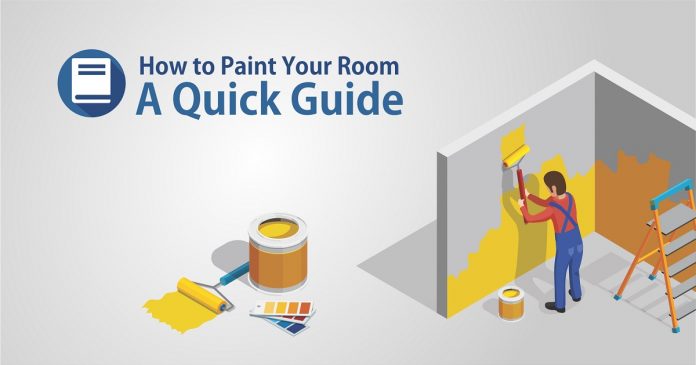Painting your room doesn’t seem like a big deal; after all, it’s something you can do yourself. In the worst case scenario, if you don’t get it right the first time, you can always fix it.
One thing you probably don’t know is that before you start splashing the paint on your walls, you need a plan. This plan should focus on three core stages; before you paint, while your painting and after painting. Below are the steps you should follow to increase your chances of painting your room successfully.

Step 1: Come Up With a Plan
You have to be deliberate on what you want your room to look like after you’re done with the painting. You should note here that you don’t necessarily have to limit yourself to using one colour on all the walls in the room. Feel free to use contrasting shades of colours and don’t be afraid to get creative.
The ceiling should also be included in your plans. The exception here is if the house is a new house and the paint on the ceiling is in pristine condition. In such a situation, there’s no point repainting it.
Step 2: Pick Your Colours
Before you choose colours to paint your room, you need to understand the psychology of colours and how to apply them. You don’t have to be a professional to make an informed decision on which colours to use.
For instance, do you want a cool shade of colour or would be prefer something warm. There are other shades you can try – Would you consider settling for a saturated shade of colour or do you prefer a colour on the neutral side?
When planning your colour, bring your existing furniture into the equation. If you don’t have a lot of wall arts or furniture, it’s okay. What you should bear in mind, however, is that the colour of your room should complement the colour of your wall art, furniture and paintings.
After settling for a colour that truly appeals to you, you need to pick some shades of those colours and get samples of them. Remember to try them out at different times of the day to be absolutely sure of what they look like in different lighting conditions. When you’re done with this, proceed to the next stage.

Step 3: Get Your Materials and Tools Ready
Depending on the scale of your painting project, you might need different tools. However, regardless of the size of the room, the kind of paint you eventually settle for or the condition of the walls, there are some basic things you need. Some of them include:
- Paint Brushes: Mostly used for cutting in (the process of painting their border areas around the taped area)
- Paint Roller: Used for most of the painting as it is faster. A pole can be attached to the roller to extend its reach
- Paint: There are different types of paint that can be used for different purposes
- Tape Measure: You need to measure the walls to know how much paint you need. Ideally, a gallon of paint should be sufficient for 400 square feet
- Old newspapers: Used to cover every inch of your floor to prevent paint from staining your flooring
- Screen: Use this to wipe off excess paint from the roller as you paint
- Tape: You need this to cover the parts of the wall that you don’t want to paint
- Stirrer: Before you apply any paint, you need to stir it
- Screwdriver: You need this to unscrew and remove ceiling plates of lighting fixtures and switches before you paint
- Gloves: This will protect your hands while you paint
- Drop Cloths: Lay these over your furniture and other valuables to protect them from getting stained
- Hole Filler: You used these to patch holes in the wall
- Sponge: You use this wash walls (before priming) by adding dishwashing detergent with water
Step 4: Find Out the Quantity of Paint Needed
When painting your room, you want to save yourself the stress of returning to the store to buy extra. You’ll also want to save yourself the wasteful feeling of buying more paint than you actually need.
The general rule here is to go with the measurement of one gallon on paint per 400 square feet. However, this is merely a rough estimate agreed upon by experts. To play it safer, professionals suggest buying 10% more than the calculated amount of paint you need.
Regardless of the size of your room, there are some other rules you need to adhere to. For instance, when you are painting from dark to light, you will need an additional amount of paint.

Step 5: Get the Walls and Room Ready
The last thing you want to do when you are painting is to have paint all over your sofa and valued furniture. Before you do any painting, you need to get everything out of the room. If you don’t have enough room in the apartment, you can push everything to the middle of the room and cover them with a drop cloth.
The floor should also be covered and this is where the old newspaper comes in. Spread the newspaper all over the floor until you have every inch of the floor covered. No matter how careful you are, you will still end up spilling paint on the floor. This is why you need to cover everything.
When getting the room ready, take a roll of painter’s tape and plaster it along the edge of the room’s base, corners, doors and window frames. It’s important to have a good seal with the tape. This helps you avoid a messy job along the edges. Remember to unscrew and remove light switch covers to protect them from dripping paint.
Step 6: Mixing the Paint
We guess you already mix paint the same way you mix your cocktail. You will mix the paint before you start painting. To mix, you need to stir the paint thoroughly with a stirrer.
You will need to re-stir the paint very often throughout the course of painting your room. In a situation where you are using more than a gallon of paint, you will need to combine the paint in a larger bucket to handle any variation in colour.

Step 7: Use the Right Painting Technique
Don’t just rush into the painting stage because you have your materials ready. Don’t settle for using your discretion just because you can. One good technique is to take one wall at a time. Start from the top and work your way down when painting your room.
Start with what is known as the ‘cut in,’ which is the process of painting along the corners of the wall; from top to bottom. When you’re done with this, you can then proceed to paint the rest of the wall. When painting the wall, consider using long strokes in a W pattern for better coverage. This also helps you avoid those annoying roller marks.
When the paint on the wall becomes dry, prepare your painting materials for the second coating. For the trim, remember to take off the painter’s tape and wait until the wall is dry before you apply the tape to the walls. Begin with the trim around the ceiling. From there, you move to the window frames and then the door and finish up with the baseboards.
Step 8: Ventilation
It’s important to ensure your room is well ventilated all through the period of painting. Keep your windows open and remember to switch the fan on. If your room has a ceiling fan, you should switch it off only when you want to paint the ceiling. The fan blades should be wrapped in old newspapers to protect them from paint stains.
A standing far that rotates works perfectly well to help improve ventilation. It also helps the paint dry faster. As you might have guessed, a damp room would make the paint take a longer time to dry. Ventilation is essential.

Step 9: Cleaning Up
After painting your room, you can’t leave the room in a mess. Start cleaning up by removing all the painter’s tape and take off all the old newspapers you used in wrapping your furniture and other items.
For the spills and splatters, ensure they are dry before moving them. You can clean paint brushes with soap and water especially for paint and water-based paints. For oil-based paints, you’ll need mineral spirits or you can just use kerosene, which is widely used in Nigeria.
If you need to reshape and clean bristles, you can use the painter’s brush. For the roller covers, consider using the curved edge of a 5-in-1 tool to take the paint off under running water.
Step 10: Don’t Rush Yourself
You need to dedicate sufficient time to paint your room. There’s no need to rush the process and end up making mistakes. The amount of time you will spend will largely depend on the size of your room, your painting skill level and your strategy. For example, it would take a shorter time to paint the walls in a neutral colour as opposed to choosing a dark shade of colour on the wall as well as painting the trim and ceiling.
The size of your room is really crucial to how much time you will spend painting. Let us put this into context – Some rooms can be painted in a few hours while some rooms are so large, it would take several days to paint the entire room.

Final Thoughts on Painting Your Room
Are you nervous about painting your room yourself? It’s quite understandable but there’s no need to be. Once you have the materials you need and you get the basics right, you’ll be fine.
You don’t have to rush through the painting process. You should, however, allocate a bit more time than you actually need as you might need to take a break or two.
Have you ever painted your room or did you hire someone to do it for you? Feel free to share your experience with us in the comment section below.









